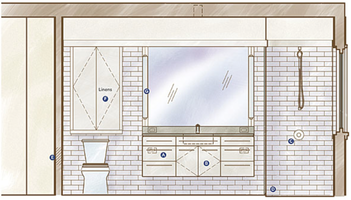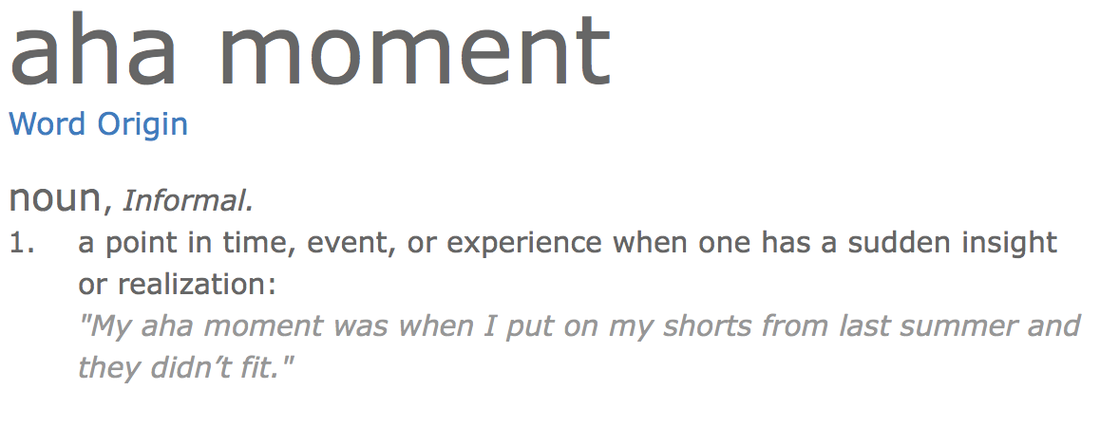 An accessible bath can be both beautiful and safe.
An accessible bath can be both beautiful and safe. Recently, a client of one of our DAASE members - we will call her Barbara - had one of those "a-ha" moments. But a little background first.
Barbara is one of the 76 million Baby Boomers who are in "age-denial" and as such, don't see a need - nor have a desire - for incorporating design features in the home that would permit them to "age in place"... or what we as DAASE members prefer to say... "Stay In Place."
The DAASE member tried to explain at length and in great detail that this wasn't the "trend du-jour" nor was it something that was going to be expensive to do during the remodeling process of the home. Adapting a home to stay-in-place usually adds about 1 to 3% of the costs. Not a bad investment considering the cost of just one extended hospital or nursing home stay.
But Barbara continued to resist approving such work such as making the master bathroom shower more accessible including getting rid of the planned shower curb for a European-style entry nor adding 3/4" plywood behind the tile walls in order that - should she need - a balance bar might be installed at some later date.
While a few things the DAASE member suggested Barbara curiously approved like wider doors and hall to the bedroom and bathroom and the addition of LED-style lighting, there was a road-block ahead.
"Why would anyone want a taller toilet with a chair-height seat? I much prefer the low-profile styles.
And I certainly don't need a grab bar that looks like it came from a gas station bathroom in my shower."
Could it be that all this rejection was because the client just really didn't want to admit that at some point, she or her spouse might need such design elements?
Perhaps this was really about the Cleopatra Syndrome. . .
The Queen of De Nile.
For a series of days and endless meetings, the DAASE member, sometimes relentlessly, continued to pursue the client in hopes that Barbara would finally give in and agree to have her newly remodeled bathroom be both "beautiful" and "safe."
"This was about making a few simple changes to the remodeling plan and that would keep the space from looking like some hospital room,"... the DAASE member explained in depth."
THEN.... the unexpected happened.
Barbara got a call from a neighbor.
The client's dear friend and colleague had taken a nasty fall during an intense match on the tennis court, breaking multiple bones in one leg and one arm. After immediate medical attention and surgery, Barbara's friend would not be able to return to their own home for a month because her friend's home couldn't accommodate a wheelchair, walker nor crutches. After a short stay in the hospital, a re-hab facility was next. Bummer.
And that is when Barbara experienced her "a-ha" moment.
Barbara is one of the 76 million Baby Boomers who are in "age-denial" and as such, don't see a need - nor have a desire - for incorporating design features in the home that would permit them to "age in place"... or what we as DAASE members prefer to say... "Stay In Place."
The DAASE member tried to explain at length and in great detail that this wasn't the "trend du-jour" nor was it something that was going to be expensive to do during the remodeling process of the home. Adapting a home to stay-in-place usually adds about 1 to 3% of the costs. Not a bad investment considering the cost of just one extended hospital or nursing home stay.
But Barbara continued to resist approving such work such as making the master bathroom shower more accessible including getting rid of the planned shower curb for a European-style entry nor adding 3/4" plywood behind the tile walls in order that - should she need - a balance bar might be installed at some later date.
While a few things the DAASE member suggested Barbara curiously approved like wider doors and hall to the bedroom and bathroom and the addition of LED-style lighting, there was a road-block ahead.
"Why would anyone want a taller toilet with a chair-height seat? I much prefer the low-profile styles.
And I certainly don't need a grab bar that looks like it came from a gas station bathroom in my shower."
Could it be that all this rejection was because the client just really didn't want to admit that at some point, she or her spouse might need such design elements?
Perhaps this was really about the Cleopatra Syndrome. . .
The Queen of De Nile.
For a series of days and endless meetings, the DAASE member, sometimes relentlessly, continued to pursue the client in hopes that Barbara would finally give in and agree to have her newly remodeled bathroom be both "beautiful" and "safe."
"This was about making a few simple changes to the remodeling plan and that would keep the space from looking like some hospital room,"... the DAASE member explained in depth."
THEN.... the unexpected happened.
Barbara got a call from a neighbor.
The client's dear friend and colleague had taken a nasty fall during an intense match on the tennis court, breaking multiple bones in one leg and one arm. After immediate medical attention and surgery, Barbara's friend would not be able to return to their own home for a month because her friend's home couldn't accommodate a wheelchair, walker nor crutches. After a short stay in the hospital, a re-hab facility was next. Bummer.
And that is when Barbara experienced her "a-ha" moment.

Accidents and sudden occurrences like in this example happen to many. It is part of life. And while one cannot plan for the unexpected, a person can make it just a wee bit easier for themselves by planning ahead.
That is where one of the members of DAASE comes in.
They have the knowledge, education and experience to help people adapt their home for the unexpected, no matter their age or ability. Their goal is designing a home that is both great looking and one that increases the homeowner's independence by making certain changes,... changes such as reducing or eliminating certain types of architectural barriers that impede mobility.
So Barbara - after her big "a-ha" moment - changed her thinking. But this time asked,... "So what else will my home need in order that I can "stay - in - place?"
The DAASE member replied that there are many ways to increase safety and security,... lever handles, lowered light switches, handles instead of knobs, level thresholds at doorways and even incorporating "green" design principles such as water and air filtration, recycling and energy conservation concepts that reduce utilities and maintenance costs.
At the end of the remodeling process, Barbara looked back on the experience and said this "....experience was really about sustaining my quality of life."
Yes, Barbara.... That's what we believe as well.
( Thanks to one of our DAASE members for sharing this story. You know who you are. )
That is where one of the members of DAASE comes in.
They have the knowledge, education and experience to help people adapt their home for the unexpected, no matter their age or ability. Their goal is designing a home that is both great looking and one that increases the homeowner's independence by making certain changes,... changes such as reducing or eliminating certain types of architectural barriers that impede mobility.
So Barbara - after her big "a-ha" moment - changed her thinking. But this time asked,... "So what else will my home need in order that I can "stay - in - place?"
The DAASE member replied that there are many ways to increase safety and security,... lever handles, lowered light switches, handles instead of knobs, level thresholds at doorways and even incorporating "green" design principles such as water and air filtration, recycling and energy conservation concepts that reduce utilities and maintenance costs.
At the end of the remodeling process, Barbara looked back on the experience and said this "....experience was really about sustaining my quality of life."
Yes, Barbara.... That's what we believe as well.
( Thanks to one of our DAASE members for sharing this story. You know who you are. )

 RSS Feed
RSS Feed